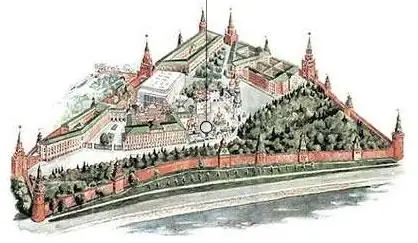- Author Harold Hamphrey [email protected].
- Public 2023-12-17 10:06.
- Last modified 2025-01-24 11:10.
Bolotnaya Square, located in the very center of Moscow, is a famous historical place. Being not far from the Kremlin, it was actively used in the political events of the country. However, this territory has been famous since ancient times for its gardens and abundance of greenery. Repin Park, which Muscovites also call Bolotny Square, today is very attractive for residents and visitors of the city, especially in summer.
In the swamp
The place called "Swamp" first appeared in documents at the beginning of the 16th century. It was hard to settle in, the drying process took a lot of energy, and the buildings of the 11th century were constantly engaged in fire. By order of Ivan III, a large garden was laid out here. Royal gardeners were forcibly settled next to fruit trees. This is how the progenitor of the current Repin Park in Moscow appeared.
The huge area was not only enough for trees, the place in the city center was chosen by merchants. It was with the appearance of shopping arcades that the mention of the place in the writings of that time is connected. And where there is trade, there is entertainment. The swamp was perfecta place for folk festivals, fisticuffs, fairs.

Historians Bolotnaya Square is known as a place of execution of rebels. Here the participants of the “Copper Riot” ended their lives, the elder Avraamy burned at the stake, the body of the executed Stepan Razin was thrown into the wasteland to intimidate the townspeople.
The garden burned down in another fire, and Bolotnaya Square alternated entertainment for curious residents - from fireworks and festivities to executions. The last execution took place here in 1775 - Emelyan Pugachev completed the list of those killed on Bolotnaya Square.
Repin Park
For many years the purpose of this place was trading. Both before the revolution and after it there were shopping arcades, warehouses, storehouses. In the 30s of the XX century, the buildings began to be used for housing, dormitories for workers were equipped. There were many development plans for Bolotnaya Square, but none of them were implemented.
On the occasion of the 800th anniversary of the capital, a park was opened on this territory, the author of the project was V. Dolganov. In 1948, front entrances with columns, a cast iron fence, vases and flower beds appeared here. A fountain started working in the square.

In 1958, a monument to the Russian artist Ilya Efimovich Repin was erected in the park, and Bolotny Square, nicknamed by the people, received the official name: “Repin Park” in 1962.
Monument to the artist
The author of the monument, M. G. Manizer, made a bronze sculpture of the artist in full growth. Ilya Efimovich looks around with an interested look, perhaps looking for an object for a new composition. That,that he was going to work is beyond doubt. He stands in a relaxed, free pose and holds brushes and a palette in his hands. The figure of Repin is set on a high pedestal of dark red stone.

The very fact of the appearance of a monument to this artist in Moscow evoked warm responses in the hearts of connoisseurs of his talent. This could happen only during the period of "thaw" in the political situation of the USSR. Repin, who spoke negatively about the autocracy in general and about the last Russian emperor in particular, also resolutely did not accept the ideas of the Soviet system. After leaving the country, he categorically refused to return from exile, despite invitations from the authorities and friends.
A monument to the great artist nevertheless appeared in the city center, in a square near the Moscow River. The Luzhkov Bridge connected Repin Park with Lavrushinsky Lane, where many of his works are kept in the Tretyakov Gallery. The monument stands in its place, but the name of the park has not taken root. It was renamed in 1993.
Modern square
Now it is again called Bolotny Park in Moscow or the public garden on Bolotnaya Square. This place is popular among young people who spend their leisure time here. On hot summer days or evenings, young people sit on the lawns, resting from the heat near the coolness of the river. This square was chosen for communication and performance by musicians, artists, firemen and many other interest groups.

Walking along the well-groomed paths of the park, people admire the majestic Moscow Kremlin, its cathedrals, the Vodootvodny Canal embankment. On theNewlyweds come to Luzhkov Bridge, great photos are obtained here.






